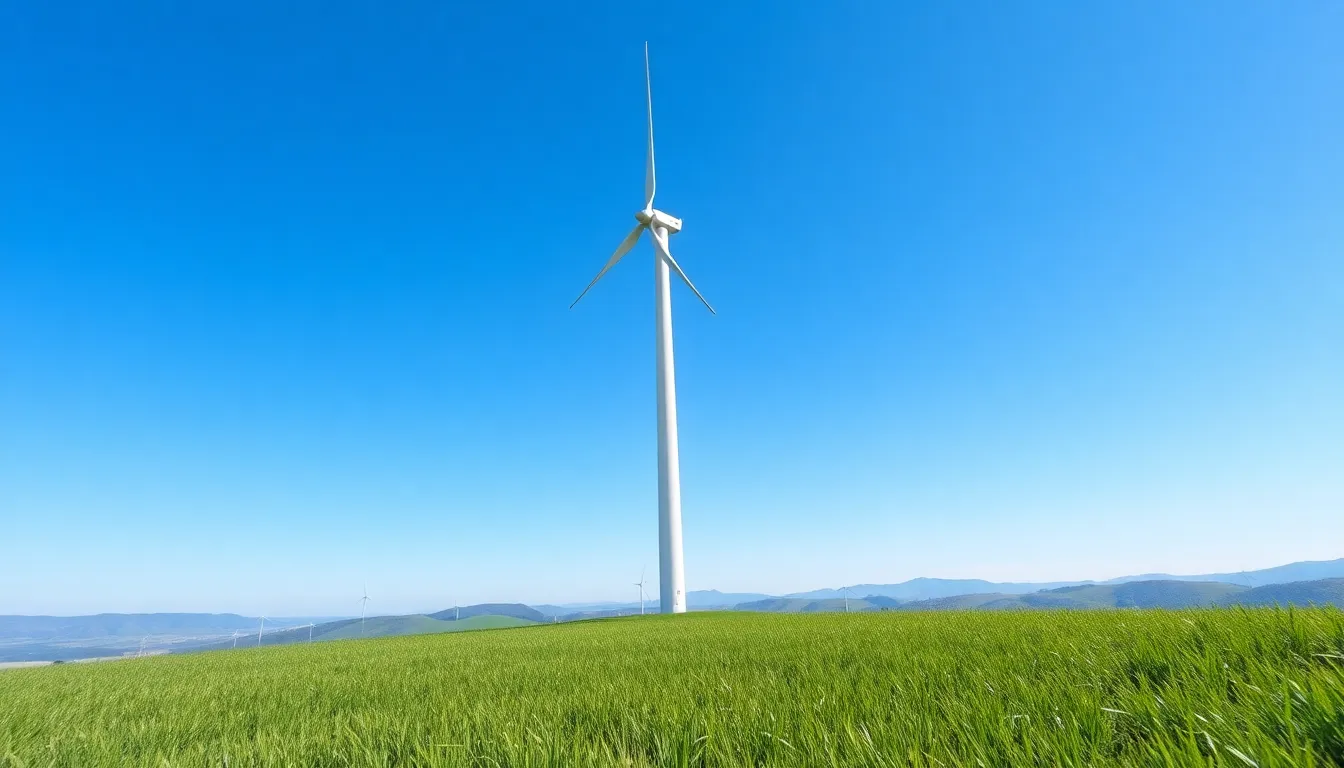In a world where the sun shines brighter than your neighbor’s new car, green energy technologies are stepping into the spotlight. These innovations are not just saving the planet; they’re also giving fossil fuels a run for their money—like a tortoise in a race against a hare that just can’t keep up. From solar panels that catch rays like a beachgoer on vacation to wind turbines spinning faster than a kid on a merry-go-round, the future is looking green and groovy.
As climate change looms like an unwelcome party guest, embracing green energy isn’t just smart; it’s essential. It’s time to swap out those outdated energy sources for something that won’t leave you feeling guilty every time you flip a switch. Dive into the world of green energy technologies and discover how they’re transforming our lives, one watt at a time.
Table of Contents
ToggleOverview of Green Energy Technologies
Green energy technologies focus on sustainable energy sources that minimize environmental impact. These technologies play a crucial role in addressing climate change by providing alternatives to fossil fuels.
Solar energy remains one of the most widely adopted forms of green technology. Photovoltaic systems convert sunlight into electricity, offering a clean energy solution that reduces carbon emissions significantly. Wind energy, generated by turbines harnessing wind power, also contributes to a substantial portion of renewable energy production.
Geothermal energy utilizes the Earth’s internal heat, offering another reliable source of power. This technology supports efficient heating and cooling systems while having a low environmental footprint. Biomass energy, derived from organic materials, transforms waste into usable fuel, highlighting the circular economy’s potential in energy production.
Hydropower systems, converting flowing water into electricity, continue to be a significant source of renewable energy across the globe. Small-scale hydroelectric plants, in particular, offer localized power solutions with reduced ecological disruption.
Advanced technologies, such as energy storage and smart grids, play a vital role in enhancing the efficiency and reliability of green energy systems. Battery storage systems allow for the accumulation of excess energy for later use, while smart grids optimize energy distribution and consumption.
Emerging technologies, including tidal and wave energy, show promise in diversifying renewable energy sources. Tidal systems utilize the gravitational pull of the moon, while wave energy converters harvest the ocean’s surface movements, adding unique advantages to energy generation portfolios.
Collectively, these technologies illustrate a growing commitment to sustainable practices. Adopting green energy innovations fuels progress toward a cleaner, more sustainable future.
Types of Green Energy Technologies

Green energy technologies encompass various methods for harnessing renewable energy sources. Each technology contributes to sustainable practices and reduces environmental impact.
Solar Energy
Solar energy captures sunlight and converts it into electricity using solar panels. Photovoltaic cells, found in these panels, facilitate the conversion process. Countries like Germany and China, prominent leaders in solar energy adoption, demonstrate significant advancements in this field. Innovations continue to enhance efficiency, with solar technologies now exceeding 22% conversion rates. The decreasing costs of solar installations encourage residential, commercial, and industrial applications.
Wind Energy
Wind energy generates power through wind turbines that convert kinetic energy into electricity. Generators inside the turbines produce electricity when the blades spin, powered by wind currents. The United States, a significant player in wind energy, boasts over 130,000 turbines installed nationwide. Turbine efficiency has improved, with modern systems capable of generating energy at lower wind speeds. This renewable resource demonstrates vast potential, particularly in regions with high wind activity like the Great Plains.
Hydropower
Hydropower utilizes flowing water to produce electricity, primarily through dam systems. Water released from reservoirs spins turbines, generating power efficiently and consistently. The World Commission on Dams reports that hydropower accounts for about 16% of global electricity production. Benefits include renewable energy generation and reliable infrastructure, but environmental impacts must be monitored. Small-scale hydroelectric projects emerge as viable alternatives, minimizing ecological disruption while enhancing local energy independence.
Biomass Energy
Biomass energy transforms organic materials into usable fuel. Materials like agricultural residues, wood chips, and dedicated energy crops offer multiple avenues for sustainable energy production. The Energy Information Administration states that biomass contributes approximately 5% to total U.S. energy consumption. Technologies in this sector continue to evolve, with advancements in biofuels and biogas production leading the way. Sustainable biomass practices promote waste reduction while providing a renewable energy source.
Geothermal Energy
Geothermal energy harnesses heat from within the Earth’s crust for electricity generation and heating. Utilizing steam or hot water from underground reservoirs, this technology contributes to low-emission energy systems. Countries like Iceland derive a large portion of their energy from geothermal sources, demonstrating its viability. Geothermal plants require a lower footprint compared to fossil fuel facilities, making them environmentally friendly. Continued research aims to enhance efficiency and explore new sites for geothermal resource extraction.
Benefits of Green Energy Technologies
Green energy technologies offer numerous advantages that impact the environment, economy, and energy independence. These benefits make the transition to renewable sources essential.
Environmental Impact
Green energy technologies significantly reduce greenhouse gas emissions. Solar, wind, and hydropower generate electricity without releasing carbon dioxide, which helps combat climate change. Water and air quality improve as fossil fuel reliance decreases. Biodiversity also benefits from the reduced habitat destruction associated with renewable energy projects. Transitioning to these technologies leads to cleaner air, revitalized ecosystems, and overall healthier communities.
Economic Advantages
Investments in green energy technologies create jobs and stimulate economic growth. The solar and wind sectors employ millions globally, with jobs ranging from manufacturing to installation. Reduced energy costs over time also result from using renewable resources, as they incur lower operational expenses. Countries leveraging green technologies attract investment, fostering innovation and sustainability. Local economies thrive through job creation, improved infrastructure, and energy savings.
Energy Independence
Adopting green energy technologies promotes energy independence. Nations dependent on fossil fuels often face geopolitical uncertainties and price volatility. By integrating renewable sources, countries can rely on domestically produced energy, enhancing security. Energy independence leads to decreased exposure to global energy markets, fostering stability. Transitioning to renewables reduces reliance on imports, paving the way for a more resilient energy future.
Challenges in Adopting Green Energy Technologies
Adopting green energy technologies presents challenges that hinder widespread implementation. Organizations notice various obstacles that must be addressed to fully benefit from renewable energy sources.
Technological Limitations
Technological advancements in green energy face limitations in efficiency and scalability. Solar panels convert sunlight into electricity, yet current models yield around 20% efficiency. Wind turbines, while effective, require consistent wind patterns to generate power effectively. Storage technologies struggle to keep pace with generation rates, creating bottlenecks in energy distribution. Geothermal systems often depend on geographical limitations, restricting access in certain regions. Innovations continue to emerge, but substantial hurdles remain before optimal solutions become widely available.
Financial Barriers
Financial constraints consistently impede adoption of green energy technologies. Initial investments for solar and wind installations can exceed $20,000, deterring many homeowners. Even governments face challenges balancing budgets while funding renewable projects. Long payback periods contribute to hesitation among businesses seeking immediate financial returns. Incentive programs and subsidies exist but often lack sufficient funding to make a significant impact. Addressing financial barriers is crucial for encouraging broader acceptance of renewable sources.
Policy and Regulation Issues
Policy and regulatory environments often present significant challenges to green energy technologies. Complex permitting processes slow down project approval and implementation, frustrating developers. Inconsistent regulations across states or countries can create confusion for investors. Existing energy policies may favor fossil fuels, hindering creativity in renewables. Advocacy for stronger policies promoting sustainability is vital for achieving progress in energy transitions. Collaboration among stakeholders simplifies navigating these regulatory landscapes, ultimately benefiting the green energy sector.
Future of Green Energy Technologies
Green energy technologies are evolving rapidly, promising a more sustainable and efficient future. The ongoing innovations aim to address current limitations while enhancing energy production.
Innovations on the Horizon
Emerging technologies like perovskite solar cells show potential for increased efficiency and lower production costs. This innovation could significantly outperform traditional silicon-based panels. Offshore wind farms are also gaining attention, leveraging stronger, more consistent winds far from shore. Dynamic technologies, such as floatovoltaics, place solar panels on bodies of water, minimizing land use. Battery storage systems improve energy reliability, capturing excess energy for later use. Research into hydrogen fuel cells for energy storage could revolutionize transportation and industry as well. Collectively, these advancements signify a promising trajectory for renewable energy sources.
Role in Climate Change Mitigation
Green energy technologies play a crucial role in combating climate change by significantly reducing greenhouse gas emissions. Transitioning from fossil fuels to renewables can decrease emissions by up to 70%. The adoption of wind and solar power reduces reliance on carbon-intensive energy sources. Renewable energy systems enhance air quality through lower pollution levels. Countries implementing green technologies often experience improved public health outcomes, decreasing healthcare costs associated with pollution. Moreover, diversifying energy sources promotes resilience against the impacts of climate change. Each advancement in green energy technologies strengthens efforts toward a more sustainable planet.
The ongoing evolution of green energy technologies marks a pivotal shift toward a sustainable future. By embracing innovations like solar panels wind turbines and advanced energy storage systems society can significantly reduce its carbon footprint while reaping economic benefits. The commitment to renewable energy not only fosters environmental well-being but also enhances energy independence and security.
As challenges persist in the adoption of these technologies stronger policies and collaborative efforts are crucial for overcoming barriers. Continued investment in research and development will pave the way for even more efficient and accessible solutions. The journey toward a greener planet is underway and every step taken toward renewable energy is a step closer to a healthier and more sustainable world.


